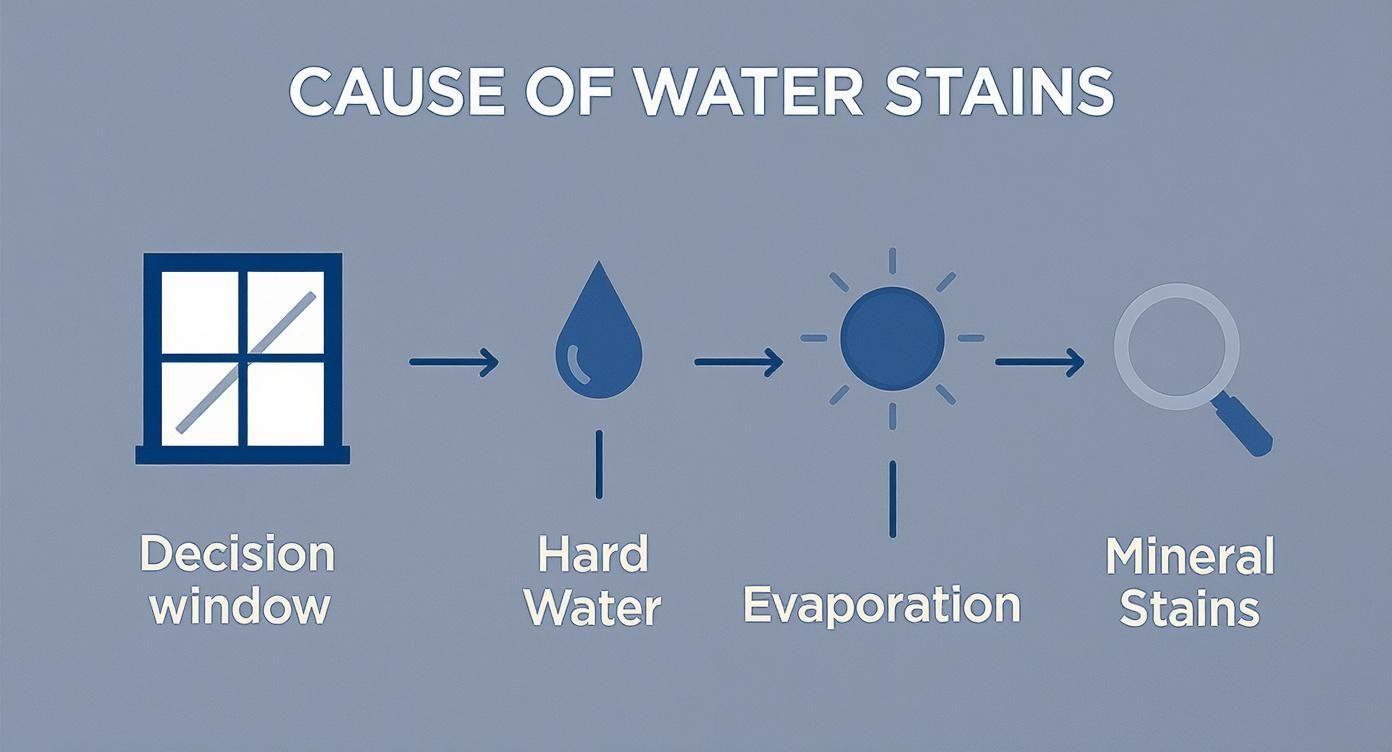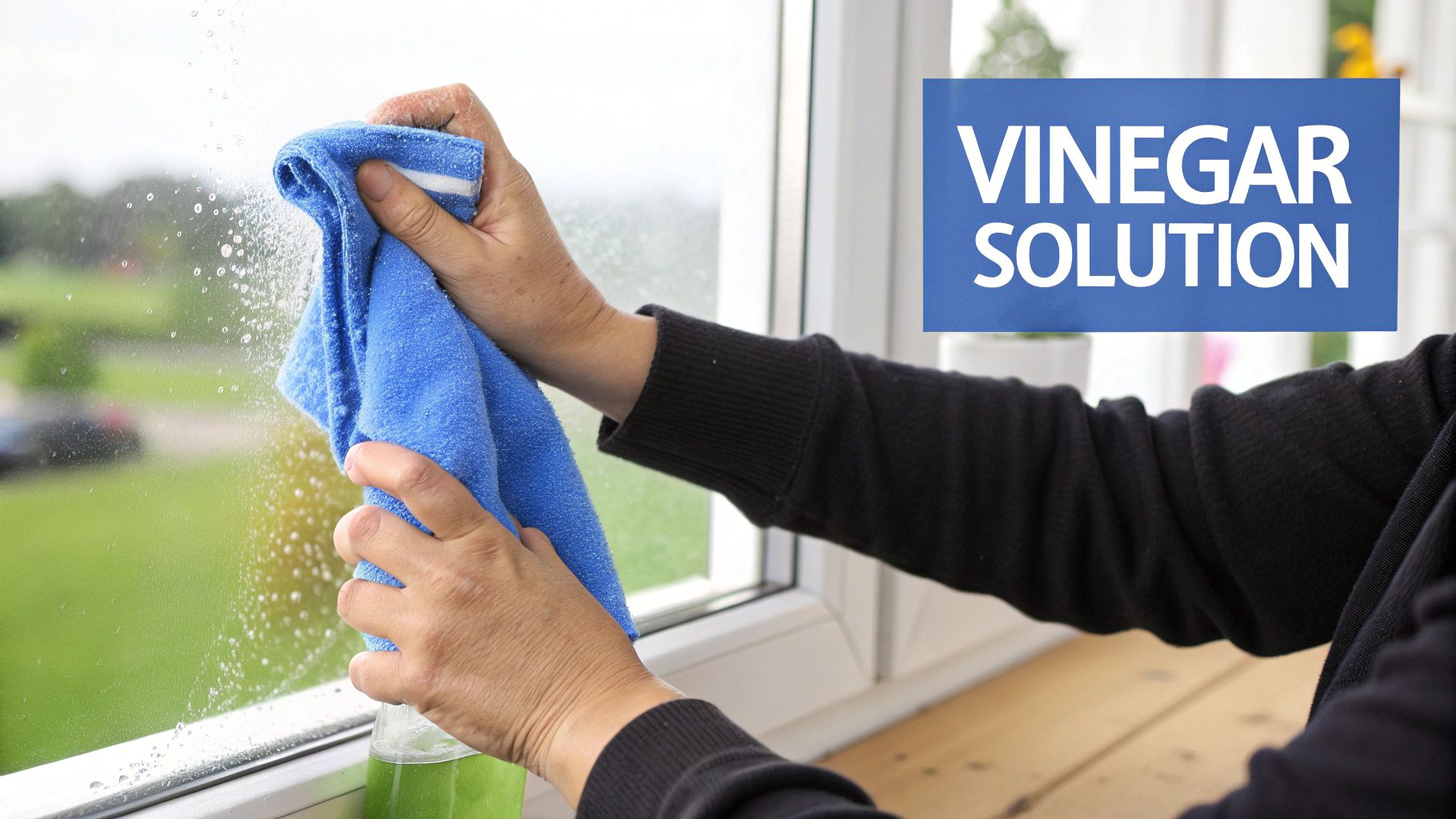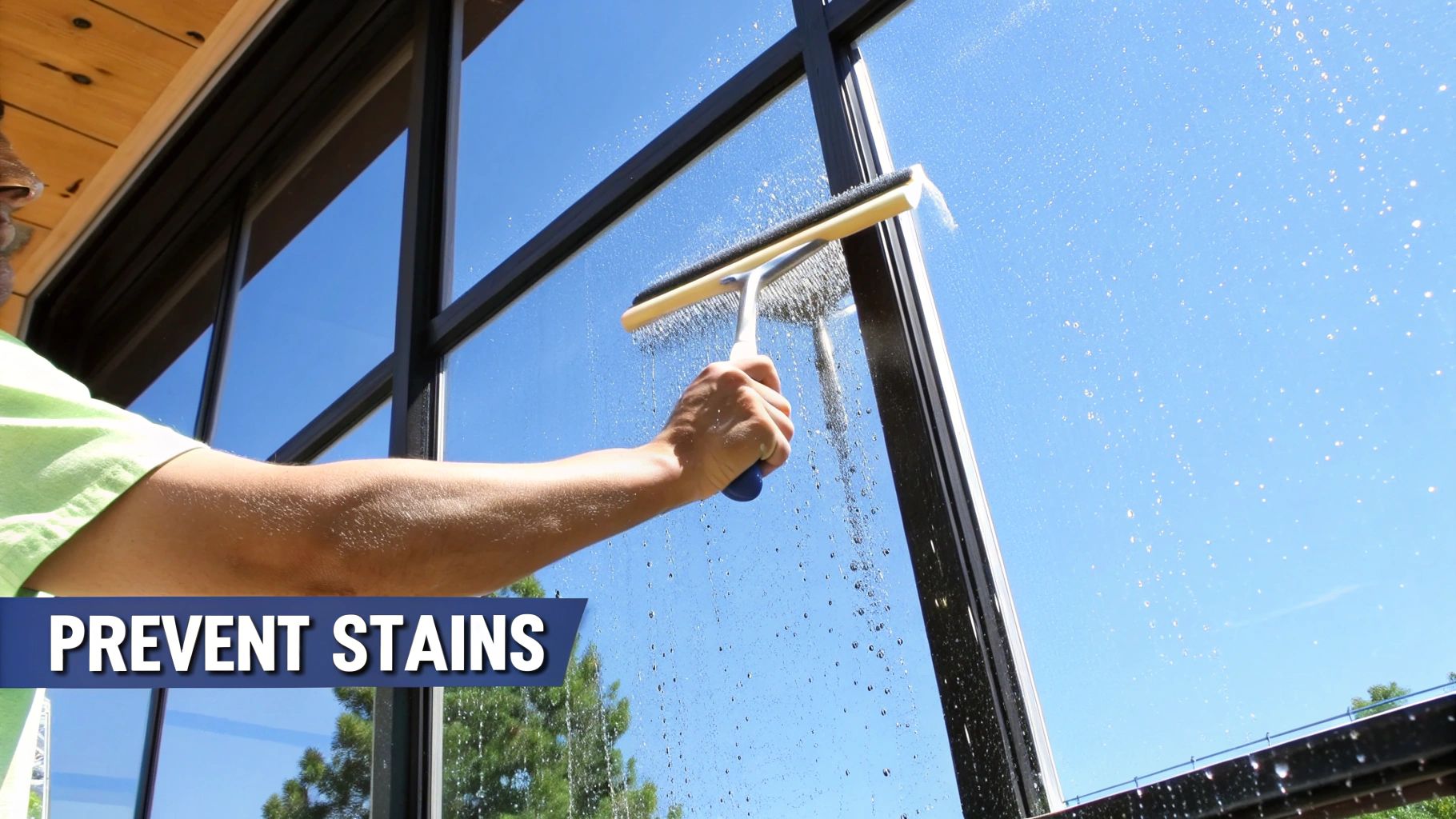Guide: how to clean water stained windows

To really learn how to clean water-stained windows, you first need to understand the enemy. Those stubborn, milky spots aren't just dirt; they're mineral deposits—mostly calcium and magnesium—left behind when water dries up on the glass.
This guide will walk you through exactly how to tackle them, depending on how long they've been sitting there.
Why Do My Windows Have Water Stains?
Before you grab a bottle of cleaner and start scrubbing, it helps to know what you’re up against. Those persistent, cloudy marks are the result of a chemical process. When water with dissolved minerals sits on your window and evaporates, the H2O is gone, but the minerals get left behind.
This is an especially common headache in areas with hard water, like Las Vegas and Phoenix. Then, the sun comes along and bakes these minerals right onto the glass. They chemically bond, which is why they’re so incredibly tough to get off with just regular window cleaner.
The Problem with Hard Water
Hard water is way more common than most people think. It’s not just a minor annoyance; it affects a huge number of homes and businesses across the country.
Believe it or not, hard water is a major issue in about 85% of American homes and nearly 60% of households in Europe. That means millions of windows end up with hard water stains every year, making timely cleaning more important than ever.
If you let them sit, these stains don't just look bad—they can cause permanent damage to your glass.
Why Time is Not on Your Side
I can't stress this enough: you need to deal with these stains as soon as you see them. After just 12–24 months, sunlight can literally "bake" the mineral deposits into the glass, causing what we call etching.
Once etching happens, restoration costs can jump by as much as 300%. In the worst cases, the only fix is to replace the window entirely. If you want to dive deeper, check out this great resource on the hard truth of hard water stains.
Now that you know what you’re dealing with, let’s get into the tools you’ll need to do the job right.
Gathering Your Cleaning Tools and Supplies
Having the right equipment is the difference between a frustrating afternoon and a crystal-clear view. Before you even think about tackling those water stains, you need a solid game plan for your supplies. For a simple DIY approach, you can actually get great results with a few household staples.
A basic kit should include white vinegar, distilled water (this is key—using tap water will just add more minerals back onto the glass), several microfiber cloths, and maybe a plastic scraper for any stubborn, crusted-on spots. This setup is perfect for fresh or light water stains you want to knock out without much hassle.
This quick visual breaks down how mineral-rich hard water and sun-driven evaporation team up to create those frustrating stains.

Ultimately, it shows that both factors are culprits in the formation of mineral deposits on your glass.
DIY vs Professional Cleaning Tools
Wondering how your home toolkit stacks up against what the pros use? It really comes down to the scale and stubbornness of the job. For everyday spots, your vinegar solution will do the trick. But for that flawless, long-lasting clarity, professional-grade equipment is in another league.
Here’s a quick comparison of what you might have on hand versus what a professional brings to your property.
As you can see, professionals invest in specialized gear designed for efficiency, safety, and a perfect finish every single time. While DIY is great for maintenance, the pros have the arsenal to restore even the most neglected windows.
Professional Grade Equipment
For a truly flawless finish, especially on tougher stains, professionals really only rely on two core methods.
The first is a high-quality squeegee, which, when used correctly, guarantees a streak-free shine that’s almost impossible to get with a cloth. It's an art form, really. You can get more details from our comprehensive guide on how to squeegee windows like a pro.
The second, and this is the real game-changer, is a pure-water system. This advanced setup uses deionized water that is so pure it naturally dissolves mineral deposits on contact. It eliminates the need for harsh chemicals and delivers impeccable, spot-free results every time. It's how we get those massive commercial windows to look absolutely perfect.
Tackling Light Stains with a DIY Vinegar Solution

When you first spot those faint, milky marks on your glass, don't panic. A simple, homemade vinegar solution is often the best first move you can make. It’s perfect for fresh water stains that haven't had years to bake into the glass, as the mild acidity in white vinegar is great at breaking down those mineral deposits.
Before you reach for something more aggressive, always start here. This home remedy is cheap, easy, and uses stuff you probably already have in your kitchen.
Mixing and Applying Your Solution
Getting the mix right is key. Just combine equal parts distilled white vinegar and distilled water in a clean spray bottle. Using distilled water isn't just a suggestion—it's a must. Tap water is full of its own minerals, and using it will only make the problem you're trying to fix even worse.
Once you’ve mixed it up, spray the solution generously onto the stained part of the window. You want the glass to be completely saturated so the vinegar has enough time to get to work on that mineral buildup.
Let the solution sit on the glass for at least 10-15 minutes. This dwell time is crucial. It gives the acetic acid in the vinegar a chance to really break down the calcium and magnesium, making the spots much easier to wipe away.
After it has soaked for a bit, take a clean microfiber cloth and gently scrub the area in a circular motion. You should start to feel the mineral gunk loosening up. To finish, rinse the glass with a little bit of clean, distilled water and dry it completely with a separate, dry microfiber cloth.
This classic vinegar-and-water trick works well for the mildest, freshest stains, which we see in about 40% of cases. But it has its limits. A 2022 survey showed that vinegar solutions only worked on 22% of hard water stains that had been sitting for six months, proving it's not a silver bullet for older, tougher jobs.
Common Mistakes to Avoid
Even with a method this simple, a few common slip-ups can sabotage your efforts. The biggest mistake I see people make is cleaning their windows in direct, hot sunlight. The heat makes your vinegar solution evaporate almost instantly, leaving behind ugly streaks and concentrated vinegar spots before it can even dissolve the minerals. Always work on a cool, cloudy day or stick to the shaded side of your home.
Also, stay away from abrasive tools like harsh scouring pads or the wrong kind of steel wool. They’ll just leave you with permanent scratches on your glass. For more tips on getting that flawless finish, you can check out our guide on how to clean windows without streaks.
Professional Methods for Severe Hard Water Stains
When your go-to vinegar solution just won't cut it against years of baked-on mineral stains, it’s time to bring out the big guns. For those really tough jobs, there are only two methods the pros trust to get a perfectly clear, streak-free finish: the classic squeegee technique and the game-changing pure-water system.
Each one has its own strengths, but both deliver a level of clean that home remedies simply can't touch. Getting familiar with what professional window cleaners use can help you decide whether it's time to upgrade your own gear or just call in an expert.
The Classic Squeegee Technique
In the hands of a pro, a squeegee is less of a tool and more of a precision instrument. It starts with a specialized applicator used to lather the window with a professional-grade soap solution. This isn't your average dish soap; it’s formulated to provide the perfect amount of "slip" to loosen dirt and minerals without leaving any residue behind.
The real magic, though, is in the squeegee work. Pros use practiced moves like the "fanning" technique to pull every last drop of water and grime off the glass in one smooth motion. This is the key to preventing streaks, as it leaves no water behind to dry and create new spots. If you're dealing with stubborn stains and want that professional-level clarity, it's worth exploring these expert strategies for professional window care and removing tough stains.
The Power of Pure Water Systems
The other method, which has truly transformed the industry, is the pure-water system. This high-tech approach uses a multi-stage filter to strip tap water of all its dissolved solids—we’re talking about the very calcium and magnesium that cause hard water stains in the first place. What you're left with is 100% pure, deionized water.
This purified water is a cleaning powerhouse because it acts like a natural solvent. It’s so pure that it aggressively attracts and dissolves minerals right off the glass, no harsh chemicals or even a squeegee required. The windows are simply scrubbed with a soft-bristled brush on a water-fed pole, rinsed with the pure water, and left to air dry to a flawless, spot-free shine.
The rise of pure water window cleaning systems has dramatically changed the professional cleaning industry. By 2019, adoption rates among professional cleaners in the US reached 65%, with these systems cleaning windows up to 30% faster than traditional methods and reducing chemical use entirely.
This technique is a lifesaver for high or hard-to-reach windows, since it allows cleaners to work safely from the ground. It's a perfect example of how technology has made the job safer, faster, and more effective.
How to Prevent Future Water Stains on Windows

After you've put in all that work to get your windows sparkling again, the last thing you want is for those milky spots to creep back. The secret to keeping them gone for good is a little bit of smart prevention. It really boils down to controlling how much water hits the glass and making the surface less friendly to mineral deposits.
One of the most common culprits I see? Sprinklers. A quick adjustment to redirect sprinkler heads so they're watering your lawn—not your windows—can make a world of difference. It’s a simple fix that cuts off a major source of hard water buildup. For those in managed communities, it's also worth looking into the broader effective common area maintenance strategies, as they often cover irrigation and building upkeep that impacts your windows.
Proactive Protection Strategies
For a truly proactive approach, I always recommend applying a hydrophobic glass sealant. Think of it as Rain-X for your home's windows. These treatments create an invisible barrier that completely changes how water behaves on the glass. Instead of clinging, flattening out, and evaporating, water beads up and rolls right off, taking all those pesky minerals with it.
This simple application can dramatically cut down on how often you need to do a deep clean. It's a small investment upfront that preserves the clarity of your glass and protects it from the long-term etching that baked-on minerals can cause.
Regular Maintenance Tips
Even with the best protective measures, some water is bound to hit your glass. A quick wipe-down after a rainstorm can save you hours of scrubbing later on. This is especially true in cities like Denver, where the hard water is notorious for leaving spots.
Here are a few habits that will keep your windows looking great:
- Squeegee After Storms: Keep a good squeegee handy. A few quick pulls across accessible windows after it rains will remove water before it has a chance to dry and spot up.
- Dry Your Window Sills: Don't let water pool on the frames and sills. It can easily splash back onto the clean glass, undoing all your hard work. A quick wipe with a microfiber cloth is all it takes.
- Schedule Routine Cleanings: Staying on top of things is key. Regular professional cleaning—even just once or twice a year—prevents the kind of severe buildup that leads to permanent damage and tough stains.
Got Questions About Water Stains? We’ve Got Answers.
Even after you’ve got the basics down, a few questions always pop up when tackling water-stained windows. Getting a straight answer can be the difference between a crystal-clear view and a bigger headache. Let's clear up some of the most common concerns we hear from folks.
Can Hard Water Stains Permanently Damage My Windows?
Yes, they absolutely can. This is the single most important thing to understand. If you let them sit, the minerals in hard water don't just rest on the glass—they start to etch into the surface permanently. The sun acts like an oven, baking those calcium and magnesium deposits right into the pores of the glass.
Before you know it, you’ve got a cloudy, hazy mess that no amount of scrubbing can fix. That’s why getting those stains off early with a good squeegee or a pure-water system is so critical. It’s about protecting your windows now to avoid a costly replacement bill later.
Is It Safe to Use Steel Wool on Glass?
This is a classic "don't try this at home" situation. While you might see a pro use super-fine #0000 grade steel wool with a special lubricant for a really tough spot, it's a risky move. Grab the wrong grade or use it dry, and you'll carve deep, permanent scratches into your glass in a heartbeat.
For any DIY cleaning, it's much smarter to stick with non-abrasive tools like a good microfiber cloth or a soft scrub pad. Going too aggressive with the wrong tool will almost always create a bigger problem than the one you started with.
How Often Should I Clean My Windows to Prevent Buildup?
Honestly, it all comes down to your property's specific situation. Are your windows getting blasted by sprinklers in an area with notoriously hard water? If so, having a pro come out every 1-3 months is a smart, preventative move.
For most homes that aren’t under constant assault from hard water, a professional cleaning once or twice a year is usually plenty. That’s enough to keep mineral buildup in check and stop permanent damage before it even thinks about starting.
Ready for a flawless, long-lasting clean that protects your investment? Trust the experts at Professional Window Cleaning. We use industry-leading pure-water and squeegee methods to bring the clarity back to your view. Get a free estimate today!
Related articles
Read our blog posts regularly and keep learning.




